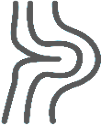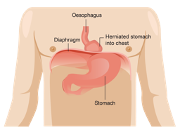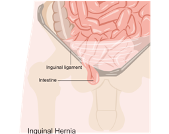About Hernia
What is a Hernia?
Generally, a hernia is a bulge or protrusion of an organ through the structure or muscle that usually contains it.
A weakness or defect may occur from birth or develop over time.
A hernia will tend to enlarge and continue to cause discomfort.

If a loop of the bowel gets caught in a hernia, it may become obstructed, or its blood supply may become impaired. A hernia that causes this type of obstruction could become a life-threatening situation.
How Does Hernia Impact Your Anatomy and Health?
The effects of a hernia on your body depend on several factors, including its location, size, and severity. Here are some general effects and potential complications associated with hernias:
- Bulge or lump
- Discomfort or pain
- Digestive issues
- Incarceration (trapping of tissue)
- Strangulation (blood supply blockage)
- Obstruction (intestinal blockage)
Risk Factors and Causes of Hernia
Hernias are typically caused by a combination of factors contributing to increased pressure on the muscles and connective tissues, weakening them and creating openings or weak spots through which organs or tissue can protrude. Here are some common risk factors and causes of hernias:
- Age: Hernia risk increases as muscles and connective tissues weaken over time.
- Gender: Some hernia types are more common in specific genders. For example, inguinal hernias are more common in males, while femoral hernias are more common in females.
- Family History: Hernias can run in families, suggesting a genetic predisposition.
- Obesity: Excess weight puts added pressure on abdominal muscles, making hernias more likely.
- Pregnancy: Pregnancy can weaken abdominal muscles and increase the risk of herniation.
- Heavy Lifting: Jobs or heavy lifting activities can strain muscles and increase hernia risk.
- Chronic Coughing or Sneezing: Conditions causing chronic coughing or sneezing can weaken abdominal tissues over time.
- Previous Abdominal Surgeries: Surgical scars can create weak spots that raise the risk of hernias.
Symptoms of Hernia
Hernias may sometimes be asymptomatic, meaning they do not cause noticeable symptoms. However, if the stomach's acid content reflux occurs (gastro-oesophageal reflux), they may experience heartburn. This is a painful burning sensation in the chest.
Sudden regurgitation of acid fluid into the mouth can occur, especially when you lie down or bend forward. These symptoms are a problem when you go to bed and can wake you up.
Other symptoms may include:
- Visible or palpable bulge
- Discomfort or pain
- Pressure or heaviness
- Burning or aching sensation
- Changes in bowel movements
- Digestive symptoms
- Nausea and vomiting
Types of Hernia
The most common types of hernia are
- Inguinal (Inner Groin),
- Incisional (resulting From An Incision),
- Femoral (Outer Groin),
- Umbilical (Belly Button), and
- Hiatal (Upper Stomach).
Incisional Hernia
In an incisional hernia, the intestine pushes through the abdominal wall at the site of the previous surgery. This type is most common in elderly or overweight people who are inactive after abdominal surgery.
Femoral Hernia
A femoral hernia occurs when the intestine enters the canal carrying the femoral artery into the upper thigh. Femoral hernias are most common in women, especially those who are pregnant or obese.
Umbilical Hernia
An umbilical hernia is a defect in the abdominal wall near the navel. It is common in newborns and afflicts women who have had many children.
Hiatal Hernia
Hiatal hernia is a condition in which part of the stomach extends through an opening of the diaphragm into the chest. The diaphragm is the sheet of muscle that divides the chest from the abdomen and is the main muscle used in breathing.
Hiatal hernia repair involves ‘reducing’ (meaning moving back down) the stomach from the chest into the abdominal cavity. The opening in the diaphragm is tightened with sutures to prevent the stomach from bulging back into the chest. The top part of the stomach, the fundus, is often wrapped around the lower oesophagus as a fundoplication to treat acid reflux.
Inguinal Hernia
Inguinal hernias most often contain fat or part of the small intestine. In girls or women, inguinal hernias, such as an ovary, may contain part of the female reproductive system. When an inguinal hernia occurs, part of the peritoneum—the lining of the abdominal cavity—bulges through the abdominal wall and forms a sac around the hernia.
Symptoms of an inguinal hernia may include a bulge in the groin, a bulge in the scrotum in males, or feelings of discomfort, pain, heaviness, or burning in the groin. Symptoms may worsen with straining, coughing, lifting, or prolonged standing.
Most people with inguinal hernias will need surgery to repair the hernia. Several different types of open and laparoscopic hernia surgery are available. The type of surgery depends on factors such as the size of the hernia and your age, health, and medical history. In both open and laparoscopic repairs, mesh is used to close and strengthen the abdominal wall.
Inguinal (groin) Hernia Recovery Chart
| Day | Pain Level | Work & School | Activity at Home & Work | Exercise & Sports |
|---|---|---|---|---|
| Day 0 - 4 1st Weekend | Moderate pain may require orally prescribed pain pills (analgesic) | Patients should expect to be off from work or school for this period. | No important plans or events should be considered for this period. Only basic daily functions should be performed, such as walking around the house, visiting the store, and eating at home. | No athletic activity should be performed during the first weekend. |
| Day 4 - 7 1st Week | Moderate pain may require orally prescribed pain pills (analgesic). | Most patients can return to work or school by postoperative Day 4. Limit lifting to 50%. | Most patients can resume light activities around the house and at work or school. | Some light stretching, biking, walking, and other slow-paced activities can be performed |
| Day 7 - 14 2nd Week | Occasional discomfort, some stiffness or soreness. Pain medication may still be required. | All patients can return to work or school with lifting limits of less than 10 kgs or 75% of normal. | Patients can resume most activities around the home and work that do not include lifting more than 10 kgs. | Jogging, biking, yoga, pilates, leisurely tennis, light weights at the gym (less than 10 kgs) |
| Day 14 - 21 3rd Week | Occasional discomfort, some stiffness or soreness. Pain medication may still be required. | All patients can return to work or school with lifting limitations of less than 10 kgs, or 75% of normal. | Return to normal home and work activities without heavy lifting (more than 10 kgs), | Running, cycling, yoga, pilates, core training, swimming, surfing, tennis, golf, or light weights at the gym (less than 10 kgs). |
| After 3rd Week | Little or no discomfort, oral medicines are no longer usually required | Patients can perform all activities at work or school without limitations. Still only limited to 95% until feeling normal again. | Return to normal home and work activities, including any required heavy lifting. | Patients can return to all sports activities, including contact sports, heavy lifting, squats, deadlifts, bench presses, etc. Also good for training and competitions. |
Diagnosis of Hernia
Hernia is typically diagnosed through physical examination, medical history review, and sometimes imaging tests.
- Physical examination: A doctor or surgeon will conduct a physical examination to assess the presence of a hernia. They will typically examine the affected area while you are standing, coughing, or straining, as these actions can make the hernia more visible or palpable. The doctor will look for any bulges or lumps and may apply gentle pressure to check for reducibility (whether the hernia can be pushed back into place).
- Medical history review: The doctor will ask you about your medical history, including any symptoms you may be experiencing. They will inquire about the location and duration of any bulges or discomfort and any factors that exacerbate or alleviate the symptoms.
- Imaging tests: In some cases, imaging tests may be ordered to confirm the diagnosis or to gather more information about the hernia. Common imaging tests used for hernia diagnosis include:
- Ultrasound: This non-invasive test uses sound waves to create images of the internal structures. Ultrasound can help determine the hernia's size, location, and contents.
- CT scan (Computed Tomography): A CT scan provides detailed cross-sectional images of the body, allowing the doctor to visualise the hernia and assess its characteristics.
- MRI (Magnetic Resonance Imaging): MRI uses magnetic fields and radio waves to generate detailed body images. It can provide information about the hernia and surrounding structures.
Combining physical examination findings, medical history, and imaging test results allows the doctor to diagnose and determine the appropriate treatment plan accurately.
Non-Surgical Treatment Options
Watchful Waiting
- In some cases, small and asymptomatic hernias may not require immediate treatment.
- Regular monitoring by a healthcare professional is recommended to ensure the hernia does not worsen or cause complications.
Lifestyle Modifications
- Weight management: Maintaining a healthy weight can help reduce pressure on the abdominal wall, potentially easing symptoms and preventing hernia progression.
- Dietary adjustments: Avoiding heavy meals, spicy foods, and foods that trigger acid reflux can help manage symptoms of hiatal hernias.
- Stop Smoking: Smoking can weaken tissues and impair healing, so quitting smoking benefits overall health and hernia management.
Supportive Measures
- Wearing a hernia belt or truss: These devices support the affected area, helping to hold the hernia in place and reduce discomfort.
- Physical therapy exercises: Specific exercises prescribed by a healthcare professional can strengthen the surrounding muscles, potentially alleviating symptoms and reducing the risk of hernia progression.
Surgical Treatment Options
Hernia Repair Surgery
Hernia Repair procedures will vary depending on the type, location and patient.
Hernia Repair may be performed as an Open Surgery, Keyhole, or Laparoscopic Surgery.
- Herniorrhaphy: In this procedure, the surgeon pushes the herniated tissue back into place and reinforces the weakened area with sutures or mesh.
- Laparoscopic surgery: A minimally invasive approach with small incisions and a laparoscope guides the surgical instruments for hernia repair.
- There are two types of laparoscopic surgery, and the most commonly used surgical techniques for hernia repair are
- Transabdominal Preperitoneal (TAPP) Repair and
- Totally Extraperitoneal (TEP) Repair.
Hernia Mesh
- Mesh reinforcement commonly strengthens the weakened area during hernia repair surgeries.
- The mesh can be made from synthetic materials or derived from animal tissue, and it supports the surrounding tissues, reducing the risk of hernia recurrence.
What if Hernia is Untreated?
If a hernia is left untreated, it can lead to various complications and potentially worsen over time. The hernia may gradually increase in size as the weakened area of the muscle or connective tissue enlarges, resulting in a more prominent bulge. Untreated hernias can cause ongoing discomfort and pain, particularly during physical activities or strain.
Hernias can lead to intestinal obstruction, tissue damage, and potential complications during hernia repair surgery without timely treatment. Therefore, it is crucial to seek medical attention if a hernia is suspected to prevent the condition's progression and minimise the risk of complications.

